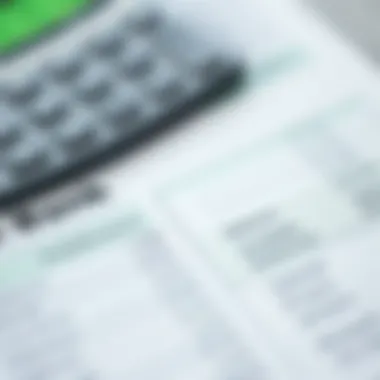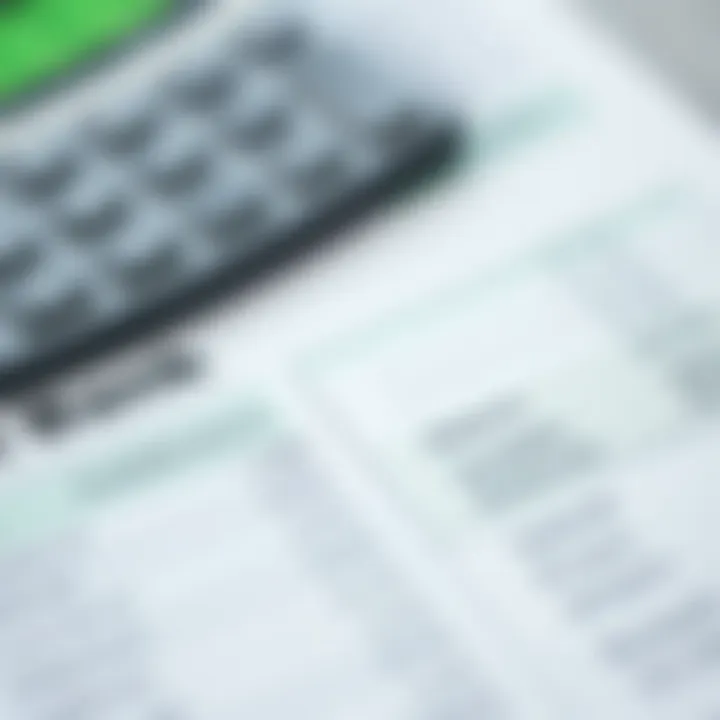Understanding Bank Account Available Balances for Finance


Intro
Navigating the world of personal finance can seem overwhelming at times, especially when it comes to understanding the ins and outs of bank account balances. Among these concepts, the term available balance frequently arises, but what does it really mean? For anyone keen on keeping their finances in tip-top shape, it's essential to grasp not only what an available balance is, but also how it relates to overall spending and saving strategies. In this article, we will break down available balances, highlighting factors that influence them, their differences from other balance types, and how they affect your financial decision-making.
As we dive deeper into this topic, expect to uncover various nuances that many overlook. Understanding these details can lead to more informed financial choices and help mitigate any potential pitfalls. From novice savers to seasoned budgeters, every reader can benefit from enhancing their comprehension of available balances in relation to their bank accounts. Now, strap in!
Investment Terminology
Definition of Key Terms
Before we delve into detailed discussions of available balances, let's clarify some key terms that come into play:
- Available Balance: This is the amount of money in your bank account that is accessible for withdrawal or use. It is important to note that this balance reflects funds that have cleared, with pending transactions not included.
- Current Balance: Unlike the available balance, the current balance shows the total amount of money in your account, including funds that are not yet available for spending due to uncleared transactions.
- Overdraft: This occurs when withdrawals from a bank account exceed the available balance, leading to a negative balance that may incur fees.
Common Acronyms and Abbreviations
In the banking and finance world, familiarity with acronyms can aid in understanding. Here are a few relevant terms:
- ATM: Automated Teller Machine, a device that lets you withdraw cash and perform other banking functions.
- ACH: Automated Clearing House, which facilitates electronic funds transfers between banks.
- FDIC: Federal Deposit Insurance Corporation, an agency that protects depositors by insuring bank deposits up to a certain limit.
Understanding these terms and abbreviations can lay the foundation for more complex ideas as we tackle the intricacies of available balances in bank accounts.
“A penny saved is a penny earned,” they say, but in personal finance, it's about knowing how to access that penny when you need it!
In the coming sections, we will explore the factors that influence available balances, their implications for day-to-day financial management, and strategies to optimize your financial health.
Overview of Bank Account Balances
Understanding bank account balances is crucial for anyone engaging in personal financial management. This introductory section aims to establish the foundation for discussions that follow, outlining why grasping the nuances of balances matters, not just for everyday transactions but also for long-term financial health. Whether you're just starting to dip your toes into budgeting or you're a seasoned investor navigating complex financial waters, the distinctions between different balance types will ultimately influence your choices and stability.
Defining Available Balance
The term available balance refers to the amount of money in your bank account that is readily accessible for withdrawal or spending. It is important to differentiate this from other types of balances, primarily because the available balance can fluctuate based on numerous factors, such as pending transactions or holds placed on funds. Essentially, it gives you a window into what you can spend without overdrawing your account. This number is your lifeline in managing day-to-day expenses and ensures you remain within your financial means.
Consider the following elements when thinking about available balances:
- Real-time access: It reflects all cleared transactions and any pending withdrawals that might not yet be subtracted from your total.
- Cash flow insight: Knowing your available balance helps track your spending behavior, prompting better budgeting choices and financial discipline.
- Financial planning: An accurate understanding of this balance can assist in monthly planning and safeguard against overdrafts, ultimately contributing to one’s overall financial health.
Understanding Current Balance
The current balance is another vital term that often gets tossed around, yet not everyone understands its implications. This balance includes all transactions that have cleared, but it does not consider any holds or pending transactions. Essentially, it's the total funds in your account that you've deposited but might not be accessible at that moment due to pending transactions or other considerations.
For example, if you deposit a check today, the current balance will reflect that deposit right away. However, if you have pending charges that are set to be deducted soon, the available balance will show a lower figure until those transactions finalize.
Here are a few things to keep in mind regarding current balances:
- Full picture of your finances: Having a grasp of your current balance can provide insights beyond available spending. It offers a broader look at your financial standing, including deposits not yet processed.
- Better planning: Knowing your current balance aids in planning your finances, especially when budgeting for future expenses or savings goals.
- Timely decisions: Being aware of both your current and available balances equips you with the necessary information to make informed financial decisions.
"The key to personal financial success lies not just in how much you earn, but in understanding the balances in your account — available and current."
These two definitions lay the groundwork for a deeper exploration of how available balances influence your overall financial health and decision-making. By comprehending the differences and keeping a close eye on both the available and current balances, individuals can navigate their financial futures with more confidence and clarity.
Components of Available Balance
Understanding available balances isn't just about keeping track of numbers in your bank account; it’s about grasping several key elements that impact your financial stability and decision-making. The available balance reflects what you can spend at any given moment. However, this figure is influenced by various components that are sometimes overlooked. Let’s dive into the nuts and bolts of these components, ensuring that you get a well-rounded understanding of how your money moves—and why it matters.
Funds Cleared and Pending Transactions
The tiniest hiccup in understanding your available balance often comes down to the difference between cleared funds and pending transactions. Cleared funds are those that have been processed and approved by your bank. When you look at your available balance and see money there, it's typically because a deposit has successfully cleared. This means you can use this money without any second thoughts about it bouncing back.
On the flip side, pending transactions are orders still awaiting processing. This could include things like a restaurant bill that you paid earlier today or an online shopping spree that hasn’t yet been finalized by the bank. Until those transactions clear, they count against your available balance.
Think of it like this: Your friend owes you $50 but hasn’t paid you back yet. You can't count that money as yours until you actually have it in your pocket, right? Likewise, pending transactions are like that debt—they reduce your available funds temporarily until they either clear or vanish into oblivion.
"Understanding the distinction between cleared funds and pending transactions is crucial for effective money management. If you're not careful, you might think you have more cash than you do, leading to unwise spending."
Deposits and Withdrawals
When looking at your account, deposits and withdrawals serve as the very foundation of your available balance. Deposits are all the money that enters your account, whether through direct deposits from your employer, checks you’ve written, or cash deposits at an ATM. However, it’s not as simple as just noting how much money comes in. Deposits can also be subject to holds, especially if they're from checks. This means that although the cash looks lovely and available online, you might have to wait a little while before you can use all that glorious spending power.
Now, withdrawals make the other half of this financial equation. Every time you take cash out, make a purchase, or set up an automatic payment, this money decreases your available balance. It's essential to track these carefully, as spending can work up a quick appetite and clean out your account faster than you might realize.
By keeping a fingers-on-the-pulse mentality about your deposits and withdrawals, you will empower yourself to manage your finances effectively. Remember that every dollar you spend has consequences—today and in the days to come. Monitoring transaction frequency and amount can actually put you in the driver's seat for solid financial planning.
In summary, comprehending the components of available balances—the interplay between cleared and pending funds, along with how deposits and withdrawals operate—is essential for anyone looking to master their personal finances. By acknowledging these factors, you increase your chances of making informed decisions about spending and saving for your future.
For further insights into financial management, you might find resources on sites like Investopedia or NerdWallet helpful.


Importance of Monitoring Available Balances
Keeping an eye on available balances in your bank account can significantly influence your financial well-being. Every financial move, be it spending, saving, or budgeting, hinges on the available balance you maintain. Understanding this concept will help ensure you have a clearer and more structured approach to your finances.
Impact on Everyday Spending
Your available balance plays a central role in determining how you handle daily expenses. When shopping or dining out, your spending decisions should ideally reflect the current available balance. It's no secret that overspending can lead to negative consequences, including overdrafts or bounced transactions.
Imagine this: you check your account and see $800 available, making you feel secure enough to splurge a bit. However, if you don't consider pending transactions or other obligations, you might find yourself in a tight spot. You're enjoying a meal, feeling carefree, but suddenly get an alert that your bank account is overdrawn because of a pending payment you overlooked. This situation happens to many, and it can easily be avoided with diligent monitoring. Remember that keeping track of your available balance isn’t just about how much money you have; it shapes your spending behavior and helps you make informed choices about your finances.
In essence, monitoring your available balance enables you to:
- Make better spending decisions. Knowing what's actually at your disposal means you can enjoy your money without the worry of negative repercussions.
- Budget more effectively. A clear understanding of your available balance can help you track expenses against your budget.
Avoiding Overdraft Fees
Nobody likes to get hit with unexpected fees, and overdraft charges can quickly add up. Many financial institutions charge hefty fees when you unintentionally spend more than what is available in your account. It's astounding how these fees can spiral; they often range from $30 to $40 or more per occurrence. For someone who may already be close to their financial limits, this can be a significant blow.
To sidestep these charges, keeping a close tab on your available balance is crucial. Here are some strategies to prevent overdraft fees:
- Set Account Alerts: Most banking apps now allow you to set alerts for when your balance drops below a certain threshold. Receiving a timely reminder could mean the difference between an enjoyable lunch and an unexpected fee.
- Opt for Overdraft Protection: Some banks offer products that provide a safety net for your expenses. While this might involve an additional charge, it can also provide the peace of mind you need by avoiding fees altogether.
- Review Transactions Regularly: This could be a weekly or even daily habit, depending on your financial habits. Making it a routine ensures your balance is always front and center in your mind.
"Monitoring your available balance is not merely a good practice; it’s a financial lifeline."
Available Balance vs. Other Balance Types
Understanding the various types of balances in bank accounts is crucial for effective personal finance management. Many people mistakenly assume that all funds that show up in their accounts are ready for immediate use. However, it's essential to differentiate between available balance and other balance types. This section will help clarify these distinctions, highlighting the significance and implications for account holders.
Distinction Between Available and Actual Balances
To start off, let’s get into what available balance actually means. The available balance is the amount of money you can spend or withdraw at any given moment. For instance, if you have $1,000 in your account, but $200 of that amount is pending due to a recent debit card transaction, your available balance will be $800. This balance can fluctuate based on the timing of transactions.
Conversely, the actual balance (or current balance) represents the total funds in your account without accounting for pending transactions. This means your actual balance is that $1,000, regardless of that pesky $200 debit you just made.
This distinction holds importance for proper financial planning. Knowing your available balance allows individuals to manage their expenditures better. Without this knowledge, it’s easy to overspend and find oneself in hot water, possibly incurring overdraft charges.
Role of Reserve Balances
Another critical balance type to understand is the reserve balance. This amount is often set aside for specific costs or to ensure sufficient funds are available for transactions that might arise. For example, banks may hold a reserve balance for certain types of transactions to manage risk and ensure liquidity.
It's important to consider the role of reserve balances when planning your finances. If you're aware that your bank keeps a portion of funds reserved, you can make better spending decisions. This understanding can prevent shortfalls on expected purchases, especially if upcoming transactions are planned.
It's also worth noting that reserve balances can be affected by bank policies or account types. For instance, some banks might have higher reserve requirements for savings accounts compared to checking accounts. Therefore, staying informed about your bank's specific policies is crucial for effective balance management.
Understanding the distinction between different balance types, including available and reserve balances, can empower individuals to forecast their financial health more accurately.
In summary, grasping the varied balance types in your bank account is more than an academic exercise. It's a vital aspect of financial literacy that can influence daily spending decisions, budgeting, and long-term financial goals. With the knowledge of how these balances coexist and affect one another, individuals can adopt proactive strategies in managing their finances.
Factors Affecting Available Balances
Understanding the various elements that influence available balances is critical for anyone managing their finances. These factors not only determine the money at your disposal at any given moment but also play a significant role in long-term financial health. Having a grasp on what affects available balances can help individuals make smarter decisions, avoiding pitfalls like overdrafts and unnecessary fees.
Transaction Timing
Timing is everything when it comes to banking. The order and timing of transactions—both deposits and withdrawals—can greatly impact your available balance.
When you make a purchase, for example, it might not immediately reflect in your available balance. The bank often requires time to clear these transactions, leading to what’s known as pending transactions. This means that when you check your balance right after a purchase, it could give you an inflated view of your available funds.
Here are some factors to consider regarding transaction timing:
- Day of the Week: Transactions processed on weekends or holidays may take longer to reflect in your balance, pushing the updates to a later business day.
- Cut-off Times: Each bank has specific cutoff times for processing transactions. If you make a withdrawal just before this cut-off, it may not reflect until the next business day.
- Payment Method: Using a debit card versus writing a check can yield different speeds in terms of transaction handling, with debit transactions often clearing faster than checks.
"Always keep in mind that what’s in your account today might not be what’s available tomorrow."
Financial Institution Policies
Different banks have various policies that affect how available balances are calculated and displayed. Understanding your bank's specific rules can save you from unnecessary surprises.
For instance:
- Hold Policies: When you deposit a check, the bank may place a hold on certain amounts for a few days. This policy is to ensure the check clears before the funds are made available for withdrawal, which can temporarily reduce your available balance.
- Withdrawal Limits: Some banks set limits on daily transactions. Exceeding this limit may prompt holds or additional fees, affecting how much money you can access on demand.
- Fee Structures: Banks that operate with different fee structures can influence your available balance. For example, maintaining a minimum balance may help you avoid monthly fees, giving you more freedom with your funds.
Understanding these policies can have considerable day-to-day effects on how you use your bank account. Knowing what to expect can help you navigate your finances preventively, allowing for budgeting that aligns with your actual available balance.
In summary, taking the time to learn about the timing of transactions and your bank's unique policies can empower you in managing your funds better, reducing risk, and maximizing availability when it counts.
Strategies for Managing Available Balances
Managing available balances in your bank account is not just about understanding the numbers; it's a pivotal strategy in personal finance management. Effective management minimizes the risk of overdrafts and ensures that funds are available when needed. Just like a tightrope walker finds balance in his steps, you too can maintain a healthy financial equilibrium through a few smart strategies.


One key strategy involves setting up alerts and notifications. These tools act as gentle nudges in a world where distractions are numerous. By getting timely updates about your account balance or pending transactions, you’re better positioned to avoid unpleasant surprises. This means fewer instances of scrambling to cover unexpected expenses, ultimately aiding your long-term financial well-being.
Another vital element is utilizing banking apps for monitoring your balances. In our tech-driven times, these apps serve as your personal finance hubs. They deliver insights into your spending habits and help you keep a finger on the pulse of your financial health. Not only do they offer convenience, but they enable proactive steps toward managing your funds effectively.
Incorporating these strategies into your daily routine can make a profound difference in how you handle financial matters. Here’s a closer look at each of these strategies:
Setting Up Alerts and Notifications
Alerts and notifications are your first line of defense when it comes to managing available balances. When you set these up, you're essentially arming yourself with real-time information about your finances. Alerts can be customized based on your preferences; for instance, you can choose to receive notifications when your balance dips below a certain threshold or when large transactions post.
- Types of Alerts
- Low Balance Alerts: These notifications let you know when your balance is nearing empty, prompting preemptive action.
- Transaction Notifications: Alerts for transactions can help you keep track of where your money is going and catch any unauthorized charges swiftly.
- Deposit Notifications: Knowing the moment your paycheck or other funds arrive can assist with budgeting and spending decisions.
Making a habit of checking your alerts regularly can ward off financial slip-ups. These reminders are designed to help you stay mindful of your spending and available balance, ensuring you never find yourself in a bind.
Utilizing Banking Apps for Monitoring
Banking apps are revolutionizing how individuals manage their finances. These apps offer a plethora of features designed to keep you informed and in control. By integrating your daily banking with modern technology, you're setting yourself up for success.
Here's how these apps can aid in balance management:
- Real-Time Updates: Get immediate insights into your available and current balance, alongside transaction history. This helps you make informed decisions quickly.
- Budgeting Tools: Many banking apps come equipped with budgeting features that categorize your transactions, offering clear pictures of your spending habits.
- Spending Analytics: Tools that analyze your spending patterns can invite you to consider areas for improvement and smarter financial planning.
By taking advantage of these applications, you cross the bridge from passive financial management to active stewardship of your funds. The ability to monitor your available balance on the go means that you've got control right in your pocket, at any given moment.
Effective management of available balances isn’t merely about numbers; it’s about cultivating healthy financial habits that pave the way toward achieving your goals.
Implementing strategies for managing your available balance can greatly diminish the stress that accompanies financial uncertainty. This doesn’t have to be overwhelming; rather, it can be an empowering journey as you learn to navigate your financial landscape with confidence.
Common Misconceptions About Available Balances
The topic of available balances is often muddled with various misunderstandings, which can lead to financial missteps for individuals. Recognizing these common misconceptions is essential for both novice and seasoned investors. Understanding the true nature of available balances can influence decision-making that ultimately impacts one’s financial health. The following segments will shed light on two critical misconceptions that frequently arise: assuming all funds are immediately accessible and mistaking available balances for current balances.
Assuming All Funds Are Immediately Available
A prevalent misconception is the belief that once money is deposited into an account, it is available for immediate use. However, this is often not the case. Various factors can delay the availability of the funds you have just deposited. For instance, when you deposit a check, the bank may place a hold on those funds until the check clears. This duration can depend on several factors including the issuer's bank, the amount, and even the type of account you’re banking with.
Additionally, understanding the terminology used by your bank can help clear the fog. If you see your deposited amount reflected in your account, you might mistakenly believe it is available, yet it could still be pending clearance. In real-world terms, this is like thinking a pizza is ready for pick-up before you've waited for it to finish baking. The immediate funds might look tempting, but they’re not up for grabs just yet.
"Always keep track of pending transactions to avoid overdrawing your account."
Confusion Between Available and Current Balances
Another area ripe for misunderstanding is the distinction between available balance and current balance. The available balance is what you can currently use; it reflects transactions that have cleared, while the current balance indicates the total amount in your account, including pending transactions. Here's a simple analogy: consider your available balance as the cash in your wallet that you can spend today. In contrast, your current balance is like the total money in your bank, which includes funds that haven't yet arrived.
Assuming both balances are the same can lead to overdrafts and unexpected fees. Picture going grocery shopping with expectations of being able to use your total current balance, only to check out and find out that you’ve got a floating transaction blocking a portion of those funds. It’s imperative to give yourself a clear account of what you actually have usable before swiping your debit card.
In summary, dispelling these misconceptions can lead to a healthier relationship with your finances. It allows for smarter budgeting, informed spending, and ultimately, more stability in managing your personal finances.
The Role of Online Banking in Balance Management
In today's fast-paced world, managing finances effectively is a must, and online banking plays a pivotal role in this process. As the digital landscape is constantly evolving, many consumers are finding it essential to utilize those online tools to keep track of their available balances. The capacity to manage finances from the comfort of one’s own home or using a mobile device transforms how individuals engage with their banks and monitor their financial health.
One of the considerable advantages online banking offers is the ability to maintain a clear view of financial standing at any given moment. This ongoing connection allows users not only to observe their available balances but also to understand the various movements, such as transactions that have yet to clear. Thus, it empowers individuals to make well-informed decisions when it comes to spending and saving.
Additionally, access to online banking presents an opportunity for users to establish smart habits. Setting up alerts and notifications regarding their account can ensure they never miss a beat regarding their personal finances. Whether it’s to avoid overspending or to prevent overdraft fees, online banking brings financial literacy to the forefront.
Benefits of Online Banking Platforms
Online banking platforms bring a slew of benefits that can greatly aid individuals in better managing their available balances. Here are some key advantages:
- Convenience: Accessing one's bank account online means no need to visit a physical branch, allowing for easier management of available balances anytime, anywhere.
- Accessibility: With online banking apps, one can check balances, transfer funds, or view recent transactions at the flick of a finger.
- Transaction History: The ability to access detailed logs provides clarity on pending transactions, which helps users to realize the full picture of their financial circumstances.
- Budgeting Tools: Many online banking services include budgeting features, enabling users to analyze spending patterns which can significantly help in financial planning.
- Instant Transfers and Payments: This allows for quick payments and transfers, which means individuals can manage their available balances efficiently and effectively—often in real-time.
Accessing Real-Time Balance Information
The highlight of online banking is undoubtedly the access it provides to real-time balance information. Understanding one's available balance in real-time can dictate the decision-making process around spending and saving. Here’s how this feature benefits users:
- Immediate Awareness: Individuals gain instant insight into how much money is available for use, thereby reducing the chances of overdrawing an account.
- Transaction Tracking: Users can watch as deposits and withdrawals happen in real-time, allowing them to correlate spending habits with their financial goals.
- Enhanced Control: Knowing one's available balance instantly helps in making on-the-spot decisions, such as whether to make a purchase, transfer funds, or set aside savings.
"Staying updated with available balance isn’t just about avoiding overdrafts; it’s about taking command of your financial future."
In summary, the role of online banking in balance management cannot be overstated. Utilizing these platforms comes with significant benefits that extend far beyond convenience. With timely access to information and powerful tools at one's fingertips, individuals can make proactive decisions that contribute to long-term financial health.
Long-Term Financial Planning and Available Balance
When it comes to managing personal finances, understanding how available balances impact long-term financial planning is crucial. It’s not just about having enough funds for today’s expenses; it’s also about strategizing for tomorrow. An available balance is a reflection of what you can actually use, which can greatly influence your budgeting decisions and savings goals. Let’s dig deeper into why this topic matters.
Incorporating Available Balance into Budgeting


Establishing a budget is a foundational step in financial planning, and an often overlooked aspect is how available balances influence this process. When drafting a budget, one must consider not just the total current funds, but also the available balance. A typical budgeting approach might involve a monthly overview, breaking down income versus expenses. However, ignoring the reality of what’s immediately accessible could lead to overspending.
For example, if you plan a budget based on the full current balance, you might overlook pending transactions that haven’t cleared yet. Being realistic about what you can spend ensures you won't find yourself in a tight spot later on. A good practice is to maintain a buffer within your budget, accounting for any expected incoming funds as well as pending expenses.
Key steps to incorporate available balance into budgeting:
- Assess your available balance regularly: Check it often to inform your spending habits.
- Account for pending transactions: Consider any expected debits before planning your expenses.
- Leave a safety net: Aim to keep a small amount reserved for unexpected costs or emergencies.
Emergency Fund Considerations
Life has a knack for throwing curveballs. That’s where an emergency fund comes into play. It’s vital that your available balances are considered when determining the size of this fund. Calculating how much to set aside requires knowing your regular expenses and upcoming financial obligations. An emergency fund acts as a financial lifebuoy; it’s there to keep you afloat during unforeseen circumstances, like medical bills or car repairs.
Many financial advisors recommend saving enough to cover three to six months' worth of living expenses. However, what does this mean in the context of your available balance? If your available balance is regularly fluctuating due to pending transactions or financial institution policies, this can impact how much you should realistically put away in your emergency fund.
To properly set this up:
- Evaluate your monthly expenses: Calculate your fixed and variable costs to determine a safety number.
- Factor in your available balance scenario: Know how much you can allocate without jeopardizing your operational funds.
- Review regularly: Finances aren’t static, so check-in on both your available balance and emergency fund regularly to ensure sufficiency.
In summary, understanding the interplay between long-term financial planning and available balances can pave the way for a more secure future. By integrating these considerations into budgeting and fostering an adequate emergency fund, you can navigate the complexities of personal finance with greater confidence.
Available Balance and Credit Decisions
Understanding the relationship between available balance and credit decisions is crucial for any individual navigating personal finance. An available balance reflects the liquid funds in a bank account that are ready for withdrawal or spending. This amount plays a significant role in shaping how financial institutions assess an individual's creditworthiness and can ultimately affect their ability to secure loans or credit.
Impact on Creditworthiness Assessments
When lenders initiate the evaluation process to determine creditworthiness, they generally take a comprehensive view of an individual’s financial profile. One key element that they often scrutinize is the available balance in bank accounts. A higher available balance can improve perceived financial stability, revealing a stronger ability to manage one’s financial obligations.
- Positive Indicators: Consistently maintaining an ample available balance can signal to lenders that you are financially responsible. This, in turn, may facilitate a smoother application process for credit products. For instance, if someone frequently has a higher available balance above a certain threshold, the lender might classify them as a lower risk, which could potentially result in more favorable interest rates.
- Financial Buffer: Furthermore, an increased available balance serves as a cushion against unexpected expenses, which could alleviate concerns for a lender regarding the person's ability to make timely repayments.
Conversely, if someone has a low available balance, it might raise red flags. Lenders may view this as an indication that the borrower is struggling to manage funds effectively, which could lead to more stringent assessment of their application for credit or loans.
Role in Loan Applications
When it comes to applying for loans, available balance plays a vital role. Lenders want to ensure that potential borrowers have not only the ability to repay the loan but also the wherewithal to manage the additional financial burden.
- Down Payments: In many cases, having a robust available balance can enable an individual to prepare a substantial down payment, which is often a requirement for sizeable loans like mortgages. A larger down payment can enhance the likelihood of loan approval and may further lead to lower monthly payments and interest rates.
- Debt-to-Income Ratio: Moreover, lenders often assess the debt-to-income ratio, and having a substantial available balance can positively affect this ratio, making the borrower look more attractive. By showcasing sufficient available funds, borrowers can demonstrate their capability to handle loans alongside their existing debts.
In summary, available balance is not just a figure on a bank statement. It is a key element in financial planning, credit evaluations, and loan applications. Monitoring and managing this balance can empower individuals, improve their credit standing, and lead to better financial opportunities in the long run.
"Financial decisions aren't just about numbers; they're about understanding the nuances that shape those numbers."
This awareness can, in turn, enhance your confidence as you engage with personal financing decisions.
Future Trends in Banking Balances
In the rapidly evolving financial landscape, staying abreast of trends that influence banking balances is crucial. With the influx of technology and changing consumer behaviors, the dynamics of available balances are shifting. Understanding these future trends not only helps consumers manage their finances better but also empowers them to seize new opportunities arising from fintech innovations and changes in how they interact with their money.
Impact of Fintech Innovations
Fintech is like a breath of fresh air in the banking sector, introducing numerous innovations that streamline how consumers manage their finances. The advent of mobile banking apps and online financial services has dramatically changed how individuals track their available balances. Users can now access real-time data about their accounts with just a few taps on their smartphones.
One significant innovation is the use of AI-driven algorithms that provide personalized financial insights. These can predict cash flow patterns and alert users when they’re nearing low balances, helping to avoid overdrafts. Moreover, services like budgeting tools integrated within banking apps allow for better financial forecasting, creating a more apparent relationship between spending habits and available balances.
"As technology advances, individuals have the tools at their fingertips to make informed decisions about their finances, ensuring their available balances are always in check."
Additionally, there is a growing trend of financial institutions collaborating with startups, leading to novel products. Examples include peer-to-peer payment systems and digital wallets, which enable instantaneous transactions. This immediacy affects how available balances are perceived; money can be transferred in seconds, making it vital for users to understand their available balances at all times.
Shifts in Consumer Behavior
The landscape of consumer behavior has also transformed, driven largely by the technological innovations in banking. Nowadays, individuals are more aware of their financial status, which leads them to constantly monitor their available balances. This heightened awareness fosters proactive financial management and encourages consumers to utilize banking services that help them manage their money more efficiently.
For instance, surveys indicate that a growing number of individuals are opting for financial literacy courses. Many consumers realize that in an age of digital banking, understanding nuances like available balances can prevent them from falling into debt traps. Furthermore, consumers are becoming more inclined toward financial freedom, leading to an increased focus on saving and budgeting that solidifies the importance of tracking available balances.
Additionally, the comfort of online services means that transactions are often completed without any physical cash involved. This has led to a shift in handling money—people are beginning to view their finances in a more abstract sense. For example, consumers often have multiple accounts linked to various apps, making it even more vital to keep an eye on what their available balance looks like across platforms.
Understanding both fintech innovations and shifts in consumer behavior is essential for future financial planning. These elements will continuously reshape banking balances, providing new opportunities for consumers to engage with their finances in a more meaningful manner. By recognizing these trends, individuals can navigate their financial journeys with greater confidence and awareness.
End: The Significance of Available Balances
Understanding available balances is pivotal for anyone managing a bank account, whether they're making everyday transactions or planning for future financial goals. The available balance plays a crucial role in determining what funds can be used immediately, setting the stage for responsible spending and effective budgeting.
The clear distinction between available balances and other balance types cannot be overstated. When individuals know their actual balance versus their available balance, it safeguards against pitfalls such as overdrafts. Those unwanted fees can stack up faster than one might expect, turning a minor miscalculation into a costly mistake.
Moreover, available balances are not just numbers on a bank statement. They represent financial flexibility. An understanding of one’s available balance influences decision-making—whether it’s splurging on a new gadget, covering bills, or setting aside emergency funds. Knowledge is power in this case.
The implications extend beyond personal spending habits. Banking institutions also factor in available balances when assessing creditworthiness. Having a solid grasp of one’s finances can significantly sway loan applications or credit limits.
"Without understanding available balances, you risk navigating your financial journey with blinders on."
In the realm of financial literacy, available balances are markers of financial health. They provide insights into spending habits and lifestyle choices. Awareness of such balances encourages users to cultivate better financial practices, ultimately enhancing overall economic well-being.
For those keen on investing or financial planning, available balances can be the linchpin to understanding cash flow. By learning about the significance of available balances, individuals arm themselves with essential knowledge that goes beyond mere bank statements.
In summary, grasping the essence of available balances is more than a financial exercise. It’s about establishing a roadmap toward smarter financial decisions and a more secure fiscal future.















